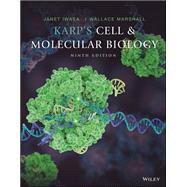Karp’s Cell and Molecular Biology delivers a concise and illustrative narrative that helps students connect key concepts and experimentation, so they better understand how we know what we know in the world of cell biology.
This classic text explores core concepts in considerable depth, often adding experimental detail. It is written in an inviting style and at mid-length, to assist students in managing the plethora of details encountered in the Cell Biology course.
The 9th Edition includes two new sections and associated assessment in each chapter that show the relevance of key cell biology concepts to plant cell biology and bioengineering.








